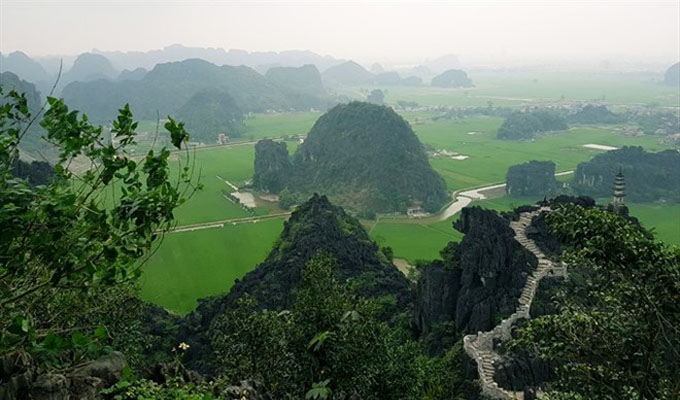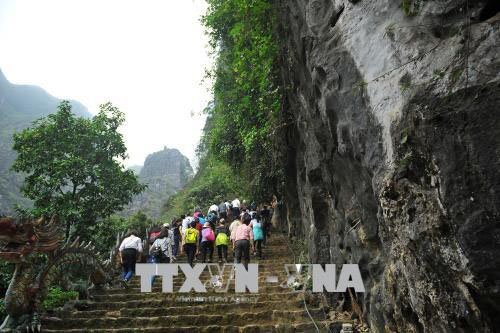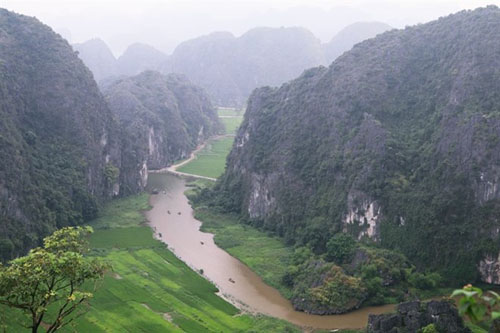For a thousands years Ninh Binh was Viet Nam’s best kept secret. Hidden away just a few hours from Ha Noi, the rural masterpiece may be small in size and population, but its rugged landscapes offer visitors a massive slice of heaven.

Ranges of moutains make a natural protective walls for Hoa Lu Citadel
In the past 50 years, Ninh Binh has seen more economic development and world recognition more ever than before.
Hoa Lu of Ninh Binh became the capital of the Great Viet in the 10th century after Dinh Bo Linh conquered the stagnant warring situation between 12 factions, united them and declared himself Emperor of the Great Viet land.
Dinh Tien Hoang became the first Emperor after one thousand years under occupation by the Han Chinese. “Hoa Lu is naturally surrounded by many mountain ranges,” according to historical records. “The mountains and rivers gracefully intertwine, making the region a convenient base camp for both land and river transportation. The forests rest behind Hoa Lu, it faces a large flatland in front, the sea is further out but within reach. This is a magnificent landscape with graceful natural fengshui, it is deserved to become the Emperor’s citadel.”
After King Ly Thai To, also a native Hoa Lu resident, moved the capital to Ha Noi, he decided to build new residences and constructions in Dai La and named them exactly the same as the sites in Hoa Lu.

King Ly Thai Tong, the second king of the Ly Dynasty was born and spent the first 10 years of his life in Hoa Lu. Later, he built One Pilar Pagoda, Dong Co Temple, dug the Lam canal to build a fortress, following the military strategy of King Le Dai Hanh.
In the early years of independence, self-defence was still top priority, so Hoa Lu was perfect for that purpose with natural high mountains scattered on a larger flatland to keep away the attackers. During the 40 year it was capital, it saw continuous war against the northern and southern neighbours.
The significance of Hoa Lu Citadel is that it was built as a self-defense fortress, which did not take any outline of any Chinese citadel. It used natural water flows as the routes to move from east side to the west side and in and out of the larger citadel area. Hoa Lu is a rare military structure set in the beautiful landscape.
In 2014, Hoa Lu together with the greater Trang An Landscape Complex became UNESCO World Heritage. It was the country’s first mixed heritage of historic and landscaping values. Trang An was recognised for "its global significance as an outstanding tropical tower-karst landscape in the final stages of geomorphic evolution.
On UNESCO website, it’s written, "The area is unique in having been invaded by the sea several times in the recent geological past but is now emergent on land. The blend of towering mountains draped in natural rain forest, with large internal basins and narrow cave passages containing quietly flowing waters, creates an extraordinarily beautiful and tranquil landscape."

Ninh Binh is well known for its breathtaking sceneries
Other archaeological findings reveal the continuous human occupation dating back to more than 30,000 years.
In 2017, Ninh Binh became known the world around after Hollywood blockbuster Kong, the Skull Island was filmed here. Kong Diretor Jordan Voigt-Roberts became Viet Nam’s Tourism Ambassador and he lived intermittently between Vietnam and the US.
Now Ninh Binh has become a popular tourist destination. In the seven-day Lunar New Year holiday in February, the number of tourists visiting Ninh Binh soared to more than 736,000 people, marking a 30 percent increase over the same period last year. By end of February 2018, the number of tourists set a new record of more than 2.3 million.
The sleeping beauty of Ninh Binh has woken up, to see itself surrounded by millions of admirers.